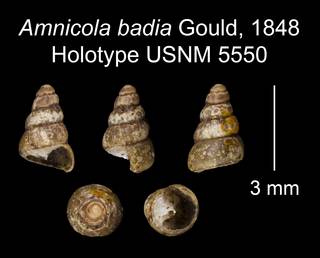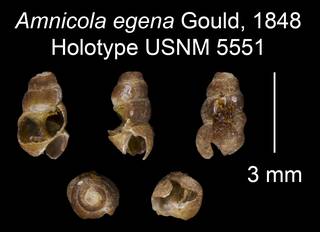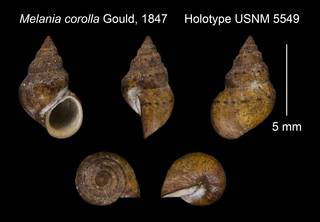WoRMS taxon details
Potamopyrgus antipodarum (J. E. Gray, 1843)
147123 (urn:lsid:marinespecies.org:taxname:147123)
accepted
Species
Amnicola antipodanum J. E. Gray, 1843 · unaccepted (superseded combination and...)
superseded combination and original misspelling
Amnicola antipodarum J. E. Gray, 1843 · unaccepted (superseded combination)
Amnicola badia A. Gould, 1848 · unaccepted (junior subjective synonym)
Amnicola corolla (A. Gould, 1847) · unaccepted (junior subjective synonym)
Amnicola egena A. Gould, 1848 · unaccepted (junior subjective synonym)
Amnicola gracilis A. Gould, 1844 · unaccepted (junior subjective synonym)
Amnicola zelandiae J. E. Gray, 1843 · unaccepted > junior subjective synonym
Bithinia legrandi Tenison Woods, 1876 · unaccepted (junior subjective synonym)
Bithinia tasmanica Tenison Woods, 1876 · unaccepted (junior subjective synonym)
Bithinia unicarinata Tenison Woods, 1876 · unaccepted (junior subjective synonym)
Bythinella exigua Tenison Woods, 1879 · unaccepted (junior subjective synonym)
Bythinella pattisoni Cotton, 1942 · unaccepted (junior subjective synonym)
Hydrobia antipodum [sic] · unaccepted > misspelling - incorrect subsequent spelling
Hydrobia fischeri Dunker, 1862 · unaccepted (junior subjective synonym)
Hydrobia jenkinsi E. A. Smith, 1889 · unaccepted (junior subjective synonym)
Hydrobia jenkinsi var. aculeata Overton, 1905 · unaccepted (junior subjective synonym)
Hydrobia reevei Frauenfeld, 1863 · unaccepted (junior subjective synonym)
Hydrobia spelaea Frauenfeld, 1863 · unaccepted (junior subjective synonym)
Hydrobia ventrosa var. carinata J. T. Marshall, 1889 · unaccepted (junior subjective synonym)
Melania corolla A. Gould, 1847 · unaccepted (junior subjective synonym)
Paludestrina cumingiana P. Fischer, 1860 · unaccepted (junior subjective synonym)
Paludestrina jenkinsi (E. A. Smith, 1889) · unaccepted (junior subjective synonym)
Paludestrina jenkinsi var. aculeata Overton, 1905 · unaccepted (junior subjective synonym)
Paludestrina legrandiana Brazier, 1872 · unaccepted (junior subjective synonym)
Paludestrina salleana P. Fischer, 1860 · unaccepted (junior subjective synonym)
Paludestrina wisemaniana Brazier, 1872 · unaccepted (junior subjective synonym)
Potamopyrgus (Potamopyrgus) jenkinsi (E. A. Smith, 1889) · unaccepted (junior subjective synonym)
Potamopyrgus (Potamopyrgus) jenkinsi septentrionalis C. R. Boettger, 1951 · unaccepted (junior subjective synonym)
Potamopyrgus alexenkoae V. Anistratenko, 1995 · unaccepted > junior subjective synonym
Potamopyrgus badia (A. Gould, 1848) · unaccepted > junior subjective synonym
Potamopyrgus corolla (A. Gould, 1847) · unaccepted > junior subjective synonym
Potamopyrgus jenkinsi (E. A. Smith, 1889) · unaccepted (junior subjective synonym)
Potamopyrgus jenkinsi var. aculeata (Overton, 1905) · unaccepted (junior subjective synonym)
Potamopyrgus polistchuki V. Anistratenko, 1991 · unaccepted > junior subjective synonym
Potamopyrgus weltneri C. R. Boettger, 1951 · unaccepted (junior subjective synonym)
Pyrgula (Trachycaspia) grossui A. N. Golikov & Starobogatov, 1966 · unaccepted (junior synonym)
Rissoa castanea G. B. Sowerby II, 1859 · unaccepted (primary homonym of R. castanea...)
primary homonym of R. castanea Møller, 1842
Rissoa vana F. W. Hutton, 1873 · unaccepted > junior subjective synonym
Rissoina fuscozona Suter, 1908 · unaccepted (junior subjective synonym)
Rissoina vana (F. W. Hutton, 1873) · unaccepted (junior subjective synonym)
recent + fossil
(of Amnicola antipodanum J. E. Gray, 1843) Gray, J. E. (1843). Catalogue of the species of Mollusca and their shells, which have hitherto been recorded as found at New Zealand, with the description of some lately discovered species. In: Dieffenbach, E. <i>Travels in New Zealand; with contributions to the geography, geology, botany, and natural history of that country</i>, vol. 2: 228-265. , available online at https://www.biodiversitylibrary.org/page/20759972
page(s): 241 [details]
page(s): 241 [details]
Type locality contained in New Zealand, New Zealand
type locality contained in New Zealand (origin: native - endemic) [details]
type locality contained in New Zealand [from synonym] [view taxon] [details]
type locality contained in New Zealand [from synonym] [view taxon] [details]
MolluscaBase eds. (2024). MolluscaBase. Potamopyrgus antipodarum (J. E. Gray, 1843). Accessed through: World Register of Marine Species at: https://www.marinespecies.org/aphia.php?p=taxdetails&id=147123 on 2024-09-22
Date
action
by
![]() The webpage text is licensed under a Creative Commons Attribution 4.0 License
The webpage text is licensed under a Creative Commons Attribution 4.0 License
original description
(of Potamopyrgus jenkinsi var. aculeata (Overton, 1905)) Overton, H. (1905). Note on a variety of Paludestrina jenkinsi E.A. Smith. <em>The Journal of Malacology.</em> 12: 15. [details]
original description (of Potamopyrgus alexenkoae V. Anistratenko, 1995) Anistratenko V.V., Stadnichenko A.P. (1994 (1995)). Mollusca. Fasc. 1. Book 2: Littoriniformes, Rissoiformes. <em>Fauna of Ukraine in 40 volumes.</em> Kiev: Naukova dumka, 29: 1- 175. [In Russian]., available online at http://ashipunov.info/shipunov/school/books/anistratenko1994_littorinoobr.djvu
page(s): 92-93, fig. 69 [details]
original description (of Potamopyrgus polistchuki V. Anistratenko, 1991) Anistratenko, V.V. (1991). Mollyuski gruppy <em>Hydrobia</em> sensu lato Chernogo i Azovskogo morey. <em>Byulleten' Moskovskogo Obshchestva Ispytateley Prirody, Otdel biologicheskiy.</em> 96(6): 73-81.
page(s): 75, fig. 1(2) [details] Available for editors [request]
[request]
original description (of Hydrobia jenkinsi E. A. Smith, 1889) Smith, E. A. (1889). Notes on British <i>Hydrobiae</i> with a description of a supposed new species. <em>Journal of Conchology.</em> 6: 142-145. [October 1889]., available online at https://www.biodiversitylibrary.org/page/31566908 [details]
original description (of Rissoina fuscozona Suter, 1908) Suter H. (1908). Additions to the marine molluscan fauna of New Zealand, with descriptions of new species. <em>Proceedings of the Malacological Society of London.</em> 8: 22-42, pls 2-3., available online at https://www.biodiversitylibrary.org/page/32058169
page(s): 32-33; plate 3, fig. 34 [details]
original description (of Rissoa vana F. W. Hutton, 1873) Hutton, F. W. (1873). Catalogue of the Tertiary Mollusca and Echinodermata of New Zealand, in the collection of the Colonial Museum. <em>Didsbury, Government Printer, Wellington.</em> xvi + 48 pp.
page(s): 12 [details]
original description (of Amnicola antipodanum J. E. Gray, 1843) Gray, J. E. (1843). Catalogue of the species of Mollusca and their shells, which have hitherto been recorded as found at New Zealand, with the description of some lately discovered species. In: Dieffenbach, E. <i>Travels in New Zealand; with contributions to the geography, geology, botany, and natural history of that country</i>, vol. 2: 228-265. , available online at https://www.biodiversitylibrary.org/page/20759972
page(s): 241 [details]
original description (of Melania corolla A. Gould, 1847) Gould, A. A. (1847). Descriptions of new shells, collected by the United States Exploring Expedition. <em>Proceedings of the Boston Society of Natural History.</em> 2: 196-198, 200-203, 204-208 [March]; 209, 210-212, 214-215, 222-224 [June]; 225, 237-239 [July]; 251-252 [December]., available online at https://www.biodiversitylibrary.org/page/9490880
page(s): 223 [details]
original description (of Amnicola egena A. Gould, 1848) Gould, A.A. (1848). [Shells collected by the United States Exploring Expedition under the command of Charles Wilkes.]. <em>Proceedings of the Boston Society of Natural History.</em> 3: 73–75., available online at https://www.biodiversitylibrary.org/page/8870375
page(s): 75 [details]
original description (of Amnicola gracilis A. Gould, 1844) Anonymous (1844). Donations to Museum. Proceedings of the Academy of Natural Sciences of Philadelphia, 2: 166-167.
page(s): 167 [details]
original description (of Amnicola zelandiae J. E. Gray, 1843) Gray, J. E. (1843). Catalogue of the species of Mollusca and their shells, which have hitherto been recorded as found at New Zealand, with the description of some lately discovered species. In: Dieffenbach, E. <i>Travels in New Zealand; with contributions to the geography, geology, botany, and natural history of that country</i>, vol. 2: 228-265. , available online at https://www.biodiversitylibrary.org/page/20759972
page(s): 241 [details]
original description (of Amnicola badia A. Gould, 1848) Gould, A.A. (1848). [Shells collected by the United States Exploring Expedition under the command of Charles Wilkes.]. <em>Proceedings of the Boston Society of Natural History.</em> 3: 73–75., available online at https://www.biodiversitylibrary.org/page/8870375
page(s): 74 [details]
original description (of Paludestrina salleana P. Fischer, 1860) Fischer, P. (1860). Descriptions d'espèces nouvelles. <em>Journal de Conchyliologie.</em> 8(2): 208–211., available online at https://www.biodiversitylibrary.org/page/15863641
page(s): 208 [details]
original description (of Paludestrina cumingiana P. Fischer, 1860) Fischer, P. (1860). Descriptions d'espèces nouvelles. <em>Journal de Conchyliologie.</em> 8(2): 208–211., available online at https://www.biodiversitylibrary.org/page/15863641
page(s): 208 [details]
original description (of Hydrobia spelaea Frauenfeld, 1863) Frauenfeld, G. von. (1863). Vorläufige Aufzählung der Arten der Gattungen <i>Hydrobia</i> Htm. und <i>Amnicola</i> Gld. Hldm. in der kaiserlichen und in Cuming's Sammlung. <em>Verhandlungen der Kaiserlich-Königlichen Zoologisch-Botanischen Gesellschaft in Wien.</em> 13, Abhandlungen: 1017-1032. Wien., available online at https://www.biodiversitylibrary.org/page/54758154
page(s): 1022 [details]
original description (of Hydrobia reevei Frauenfeld, 1863) Frauenfeld, G. von. (1863). Vorläufige Aufzählung der Arten der Gattungen <i>Hydrobia</i> Htm. und <i>Amnicola</i> Gld. Hldm. in der kaiserlichen und in Cuming's Sammlung. <em>Verhandlungen der Kaiserlich-Königlichen Zoologisch-Botanischen Gesellschaft in Wien.</em> 13, Abhandlungen: 1017-1032. Wien., available online at https://www.biodiversitylibrary.org/page/54758154
page(s): 1024 [details]
original description (of Paludestrina legrandiana Brazier, 1872) Brazier, J. (1872). Descriptions of seven new species of the genus <i>Helix</i>, and of two fluviatile shells from Tasmania. <em>Proceedings of the Zoological Society of London.</em> 1871: 696–699., available online at https://www.biodiversitylibrary.org/page/28554634
page(s): 698 [details]
original description (of Paludestrina wisemaniana Brazier, 1872) Brazier, J. (1872). Descriptions of seven new species of the genus <i>Helix</i>, and of two fluviatile shells from Tasmania. <em>Proceedings of the Zoological Society of London.</em> 1871: 696–699., available online at https://www.biodiversitylibrary.org/page/28554634
page(s): 699 [details]
original description (of Bithinia legrandi Tenison Woods, 1876) Tenison Woods, J. E. (1876). On the freshwater shells of Tasmania. <em>Papers and Proceedings of the Royal Society of Tasmania.</em> 1875: 66-82., available online at https://www.biodiversitylibrary.org/page/12289039
page(s): 76 [details]
original description (of Bithinia unicarinata Tenison Woods, 1876) Tenison Woods, J. E. (1876). On the freshwater shells of Tasmania. <em>Papers and Proceedings of the Royal Society of Tasmania.</em> 1875: 66-82., available online at https://www.biodiversitylibrary.org/page/12289039
page(s): 77 [details]
original description (of Bithinia tasmanica Tenison Woods, 1876) Tenison Woods, J. E. (1876). On the freshwater shells of Tasmania. <em>Papers and Proceedings of the Royal Society of Tasmania.</em> 1875: 66-82., available online at https://www.biodiversitylibrary.org/page/12289039
page(s): 77 [details]
original description (of Hydrobia ventrosa var. carinata J. T. Marshall, 1889) Marshall, J. T. (1889). On hydrobiae and assimineae from the Thames valley. <em>Journal of Conchology.</em> 6: 140-141.
page(s): 141 [details]
original description (of Bythinella pattisoni Cotton, 1942) Cotton, B. C. (1942). Some Australian freshwater Gasteropoda. <em>Transactions of the Royal Society of South Australia.</em> 66: 75-82., available online at https://www.biodiversitylibrary.org/page/41569225
page(s): 81 [details]
original description (of Bythinella exigua Tenison Woods, 1879) Tenison Woods, J. E. (1879). On some Tasmanian freshwater univalves. <em>Papers and Proceedings of the Royal Society of Tasmania.</em> 1878: 65-72., available online at https://www.biodiversitylibrary.org/page/26235200
page(s): 71 [details]
original description (of Potamopyrgus (Potamopyrgus) jenkinsi septentrionalis C. R. Boettger, 1951) Boettger, C. R. (1951). Die herkunft und Verwandtschaftsbeziehungen der Wasserschnecke <i>Potamopyrgus jenkinsi</i> E.A. Smith, nebst einer Angabe über ihr Auftreten im Mediterrangebiet. <em>Archive für Molluskenkunde.</em> 80: 57–85.
page(s): 66 [details]
original description (of Pyrgula (Trachycaspia) grossui A. N. Golikov & Starobogatov, 1966) Golikov, A.N.; Starobogatov, Y.I. (1966). Ponto-Caspian gastropod molluscs in the Azov-Black Sea Basin [Понто-каспийские брюхоногие моллюски в Азово-Черноморском бассейне]. <em>Zoologicheskiy Zhurnal.</em> 45(3): 352-362.
page(s): 359 [details] Available for editors [request]
[request]
original description (of Paludestrina jenkinsi var. aculeata Overton, 1905) Overton, H. (1905). Note on a variety of Paludestrina jenkinsi E.A. Smith. <em>The Journal of Malacology.</em> 12: 15. [details]
original description (of Hydrobia fischeri Dunker, 1862) Dunker, W. (1862). Beschreibungen einiger von Herrn Dr. v. Hochstetter auf Neuseeland gesammelten Süsswasser-Mollusken. <em>Malakozoologische Blätter.</em> 8: 150–154., available online at https://www.biodiversitylibrary.org/page/15919963
page(s): 152 [details]
original description (of Hydrobia jenkinsi var. aculeata Overton, 1905) Overton, H. (1905). Note on a variety of Paludestrina jenkinsi E.A. Smith. <em>The Journal of Malacology.</em> 12: 15.
page(s): 15 [details]
original description (of Potamopyrgus weltneri C. R. Boettger, 1951) Boettger, C. R. (1951). Die herkunft und Verwandtschaftsbeziehungen der Wasserschnecke <i>Potamopyrgus jenkinsi</i> E.A. Smith, nebst einer Angabe über ihr Auftreten im Mediterrangebiet. <em>Archive für Molluskenkunde.</em> 80: 57–85.
page(s): 68 [details]
original description (of Rissoa castanea G. B. Sowerby II, 1859) Sowerby, G. B. II. (1859). <i>Illustrated Index of British Shells. Containing Figures of all the Recent Species, with Names and Other Information</i>. Simpkin, Marshall, & Co., London, xii pp., 24 pls. , available online at http://www.biodiversitylibrary.org/item/48938 [details]
context source (Introduced species) Katsanevakis, S.; Bogucarskis, K.; Gatto, F.; Vandekerkhove, J.; Deriu, I.; Cardoso A.S. (2012). Building the European Alien Species Information Network (EASIN): a novel approach for the exploration of distributed alien species data. <em>BioInvasions Records.</em> 1: 235-245., available online at http://easin.jrc.ec.europa.eu [details] Available for editors [request]
[request]
context source (Schelde) Maris, T.; Beauchard, O.; Van Damme, S.; Van den Bergh, E.; Wijnhoven, S.; Meire, P. (2013). Referentiematrices en Ecotoopoppervlaktes Annex bij de Evaluatiemethodiek Schelde-estuarium Studie naar “Ecotoopoppervlaktes en intactness index”. <em>Monitor Taskforce Publication Series, 2013-01. NIOZ: Yerseke.</em> 35 pp. (look up in IMIS) [details]
basis of record de Kluijver, M. J.; Ingalsuo, S. S.; de Bruyne, R. H. (2000). Macrobenthos of the North Sea [CD-ROM]: 1. Keys to Mollusca and Brachiopoda. <em>World Biodiversity Database CD-ROM Series. Expert Center for Taxonomic Identification (ETI): Amsterdam, The Netherlands. ISBN 3-540-14706-3. 1 cd-rom.</em> (look up in IMIS) [details]
additional source Streftaris, N., A. Zenetos & E. Papathanassiou. (2005). Globalisation in marine ecosystems: the story of non-indigenous marine species across European seas. <em>Oceanogry and Marine Biology: an Annual Review.</em> 43: 419-453. (look up in IMIS) [details] Available for editors [request]
[request]
additional source Spencer, H.G., Marshall, B.A. & Willan, R.C. (2009). Checklist of New Zealand living Mollusca. Pp 196-219. <em>in: Gordon, D.P. (ed.) New Zealand inventory of biodiversity. Volume one. Kingdom Animalia: Radiata, Lophotrochozoa, Deuterostomia.</em> Canterbury University Press, Christchurch. [details]
additional source Haase, M. (2008). The radiation of hydrobiid gastropods in New Zealand: A revision including the description of new species based on morphology and mtDNA sequence information. <em>Systematics and Biodiversity.</em> 6(1): 99-159., available online at https://doi.org/10.1017/s1477200007002630 [details] Available for editors [request]
[request]
additional source Ponder, W.F. (1988). Potamopyrgus antipodarum - a molluscan coloniser of Europe and Australia. Journal of Molluscan Studies, 54: 271-285. London. [details]
additional source Hamada, K.; Takeda, N.; Tatara, Y.; Ogata, D.; Nakajima, M.; Sonohara, T.; Urabe, M. (2013). Habitat Description of Potamopyrgus antipodarum (Caenogastropoda: Hydrobiidae) in Some Areas of Japan: How Far Will It Spread?. <em>Venus (Journal of the Malacological Society of Japan).</em> 71 (1-2): 61-79. [details] Available for editors [request]
[request]
additional source Shimada, K.; Urabe, M. (2003). Comparative Ecology of the Alien Freshwater Snail Potamopyrgus αntipodarum and the Indigenous Snail Semisulcospira spp. <em>Venus (Journal of the Malacological Society of Japan).</em> 62 (1-2): 39-53. [details] Available for editors [request]
[request]
identification resource Rowson, B., Powell, H., Willing, M., Dobson, M. & Shaw, H. (2021). Freshwater Snails of Britain and Ireland. FSC Publications, Telford, UK.
page(s): 146. [details]
original description (of Potamopyrgus alexenkoae V. Anistratenko, 1995) Anistratenko V.V., Stadnichenko A.P. (1994 (1995)). Mollusca. Fasc. 1. Book 2: Littoriniformes, Rissoiformes. <em>Fauna of Ukraine in 40 volumes.</em> Kiev: Naukova dumka, 29: 1- 175. [In Russian]., available online at http://ashipunov.info/shipunov/school/books/anistratenko1994_littorinoobr.djvu
page(s): 92-93, fig. 69 [details]
original description (of Potamopyrgus polistchuki V. Anistratenko, 1991) Anistratenko, V.V. (1991). Mollyuski gruppy <em>Hydrobia</em> sensu lato Chernogo i Azovskogo morey. <em>Byulleten' Moskovskogo Obshchestva Ispytateley Prirody, Otdel biologicheskiy.</em> 96(6): 73-81.
page(s): 75, fig. 1(2) [details] Available for editors
original description (of Hydrobia jenkinsi E. A. Smith, 1889) Smith, E. A. (1889). Notes on British <i>Hydrobiae</i> with a description of a supposed new species. <em>Journal of Conchology.</em> 6: 142-145. [October 1889]., available online at https://www.biodiversitylibrary.org/page/31566908 [details]
original description (of Rissoina fuscozona Suter, 1908) Suter H. (1908). Additions to the marine molluscan fauna of New Zealand, with descriptions of new species. <em>Proceedings of the Malacological Society of London.</em> 8: 22-42, pls 2-3., available online at https://www.biodiversitylibrary.org/page/32058169
page(s): 32-33; plate 3, fig. 34 [details]
original description (of Rissoa vana F. W. Hutton, 1873) Hutton, F. W. (1873). Catalogue of the Tertiary Mollusca and Echinodermata of New Zealand, in the collection of the Colonial Museum. <em>Didsbury, Government Printer, Wellington.</em> xvi + 48 pp.
page(s): 12 [details]
original description (of Amnicola antipodanum J. E. Gray, 1843) Gray, J. E. (1843). Catalogue of the species of Mollusca and their shells, which have hitherto been recorded as found at New Zealand, with the description of some lately discovered species. In: Dieffenbach, E. <i>Travels in New Zealand; with contributions to the geography, geology, botany, and natural history of that country</i>, vol. 2: 228-265. , available online at https://www.biodiversitylibrary.org/page/20759972
page(s): 241 [details]
original description (of Melania corolla A. Gould, 1847) Gould, A. A. (1847). Descriptions of new shells, collected by the United States Exploring Expedition. <em>Proceedings of the Boston Society of Natural History.</em> 2: 196-198, 200-203, 204-208 [March]; 209, 210-212, 214-215, 222-224 [June]; 225, 237-239 [July]; 251-252 [December]., available online at https://www.biodiversitylibrary.org/page/9490880
page(s): 223 [details]
original description (of Amnicola egena A. Gould, 1848) Gould, A.A. (1848). [Shells collected by the United States Exploring Expedition under the command of Charles Wilkes.]. <em>Proceedings of the Boston Society of Natural History.</em> 3: 73–75., available online at https://www.biodiversitylibrary.org/page/8870375
page(s): 75 [details]
original description (of Amnicola gracilis A. Gould, 1844) Anonymous (1844). Donations to Museum. Proceedings of the Academy of Natural Sciences of Philadelphia, 2: 166-167.
page(s): 167 [details]
original description (of Amnicola zelandiae J. E. Gray, 1843) Gray, J. E. (1843). Catalogue of the species of Mollusca and their shells, which have hitherto been recorded as found at New Zealand, with the description of some lately discovered species. In: Dieffenbach, E. <i>Travels in New Zealand; with contributions to the geography, geology, botany, and natural history of that country</i>, vol. 2: 228-265. , available online at https://www.biodiversitylibrary.org/page/20759972
page(s): 241 [details]
original description (of Amnicola badia A. Gould, 1848) Gould, A.A. (1848). [Shells collected by the United States Exploring Expedition under the command of Charles Wilkes.]. <em>Proceedings of the Boston Society of Natural History.</em> 3: 73–75., available online at https://www.biodiversitylibrary.org/page/8870375
page(s): 74 [details]
original description (of Paludestrina salleana P. Fischer, 1860) Fischer, P. (1860). Descriptions d'espèces nouvelles. <em>Journal de Conchyliologie.</em> 8(2): 208–211., available online at https://www.biodiversitylibrary.org/page/15863641
page(s): 208 [details]
original description (of Paludestrina cumingiana P. Fischer, 1860) Fischer, P. (1860). Descriptions d'espèces nouvelles. <em>Journal de Conchyliologie.</em> 8(2): 208–211., available online at https://www.biodiversitylibrary.org/page/15863641
page(s): 208 [details]
original description (of Hydrobia spelaea Frauenfeld, 1863) Frauenfeld, G. von. (1863). Vorläufige Aufzählung der Arten der Gattungen <i>Hydrobia</i> Htm. und <i>Amnicola</i> Gld. Hldm. in der kaiserlichen und in Cuming's Sammlung. <em>Verhandlungen der Kaiserlich-Königlichen Zoologisch-Botanischen Gesellschaft in Wien.</em> 13, Abhandlungen: 1017-1032. Wien., available online at https://www.biodiversitylibrary.org/page/54758154
page(s): 1022 [details]
original description (of Hydrobia reevei Frauenfeld, 1863) Frauenfeld, G. von. (1863). Vorläufige Aufzählung der Arten der Gattungen <i>Hydrobia</i> Htm. und <i>Amnicola</i> Gld. Hldm. in der kaiserlichen und in Cuming's Sammlung. <em>Verhandlungen der Kaiserlich-Königlichen Zoologisch-Botanischen Gesellschaft in Wien.</em> 13, Abhandlungen: 1017-1032. Wien., available online at https://www.biodiversitylibrary.org/page/54758154
page(s): 1024 [details]
original description (of Paludestrina legrandiana Brazier, 1872) Brazier, J. (1872). Descriptions of seven new species of the genus <i>Helix</i>, and of two fluviatile shells from Tasmania. <em>Proceedings of the Zoological Society of London.</em> 1871: 696–699., available online at https://www.biodiversitylibrary.org/page/28554634
page(s): 698 [details]
original description (of Paludestrina wisemaniana Brazier, 1872) Brazier, J. (1872). Descriptions of seven new species of the genus <i>Helix</i>, and of two fluviatile shells from Tasmania. <em>Proceedings of the Zoological Society of London.</em> 1871: 696–699., available online at https://www.biodiversitylibrary.org/page/28554634
page(s): 699 [details]
original description (of Bithinia legrandi Tenison Woods, 1876) Tenison Woods, J. E. (1876). On the freshwater shells of Tasmania. <em>Papers and Proceedings of the Royal Society of Tasmania.</em> 1875: 66-82., available online at https://www.biodiversitylibrary.org/page/12289039
page(s): 76 [details]
original description (of Bithinia unicarinata Tenison Woods, 1876) Tenison Woods, J. E. (1876). On the freshwater shells of Tasmania. <em>Papers and Proceedings of the Royal Society of Tasmania.</em> 1875: 66-82., available online at https://www.biodiversitylibrary.org/page/12289039
page(s): 77 [details]
original description (of Bithinia tasmanica Tenison Woods, 1876) Tenison Woods, J. E. (1876). On the freshwater shells of Tasmania. <em>Papers and Proceedings of the Royal Society of Tasmania.</em> 1875: 66-82., available online at https://www.biodiversitylibrary.org/page/12289039
page(s): 77 [details]
original description (of Hydrobia ventrosa var. carinata J. T. Marshall, 1889) Marshall, J. T. (1889). On hydrobiae and assimineae from the Thames valley. <em>Journal of Conchology.</em> 6: 140-141.
page(s): 141 [details]
original description (of Bythinella pattisoni Cotton, 1942) Cotton, B. C. (1942). Some Australian freshwater Gasteropoda. <em>Transactions of the Royal Society of South Australia.</em> 66: 75-82., available online at https://www.biodiversitylibrary.org/page/41569225
page(s): 81 [details]
original description (of Bythinella exigua Tenison Woods, 1879) Tenison Woods, J. E. (1879). On some Tasmanian freshwater univalves. <em>Papers and Proceedings of the Royal Society of Tasmania.</em> 1878: 65-72., available online at https://www.biodiversitylibrary.org/page/26235200
page(s): 71 [details]
original description (of Potamopyrgus (Potamopyrgus) jenkinsi septentrionalis C. R. Boettger, 1951) Boettger, C. R. (1951). Die herkunft und Verwandtschaftsbeziehungen der Wasserschnecke <i>Potamopyrgus jenkinsi</i> E.A. Smith, nebst einer Angabe über ihr Auftreten im Mediterrangebiet. <em>Archive für Molluskenkunde.</em> 80: 57–85.
page(s): 66 [details]
original description (of Pyrgula (Trachycaspia) grossui A. N. Golikov & Starobogatov, 1966) Golikov, A.N.; Starobogatov, Y.I. (1966). Ponto-Caspian gastropod molluscs in the Azov-Black Sea Basin [Понто-каспийские брюхоногие моллюски в Азово-Черноморском бассейне]. <em>Zoologicheskiy Zhurnal.</em> 45(3): 352-362.
page(s): 359 [details] Available for editors
original description (of Paludestrina jenkinsi var. aculeata Overton, 1905) Overton, H. (1905). Note on a variety of Paludestrina jenkinsi E.A. Smith. <em>The Journal of Malacology.</em> 12: 15. [details]
original description (of Hydrobia fischeri Dunker, 1862) Dunker, W. (1862). Beschreibungen einiger von Herrn Dr. v. Hochstetter auf Neuseeland gesammelten Süsswasser-Mollusken. <em>Malakozoologische Blätter.</em> 8: 150–154., available online at https://www.biodiversitylibrary.org/page/15919963
page(s): 152 [details]
original description (of Hydrobia jenkinsi var. aculeata Overton, 1905) Overton, H. (1905). Note on a variety of Paludestrina jenkinsi E.A. Smith. <em>The Journal of Malacology.</em> 12: 15.
page(s): 15 [details]
original description (of Potamopyrgus weltneri C. R. Boettger, 1951) Boettger, C. R. (1951). Die herkunft und Verwandtschaftsbeziehungen der Wasserschnecke <i>Potamopyrgus jenkinsi</i> E.A. Smith, nebst einer Angabe über ihr Auftreten im Mediterrangebiet. <em>Archive für Molluskenkunde.</em> 80: 57–85.
page(s): 68 [details]
original description (of Rissoa castanea G. B. Sowerby II, 1859) Sowerby, G. B. II. (1859). <i>Illustrated Index of British Shells. Containing Figures of all the Recent Species, with Names and Other Information</i>. Simpkin, Marshall, & Co., London, xii pp., 24 pls. , available online at http://www.biodiversitylibrary.org/item/48938 [details]
context source (Introduced species) Katsanevakis, S.; Bogucarskis, K.; Gatto, F.; Vandekerkhove, J.; Deriu, I.; Cardoso A.S. (2012). Building the European Alien Species Information Network (EASIN): a novel approach for the exploration of distributed alien species data. <em>BioInvasions Records.</em> 1: 235-245., available online at http://easin.jrc.ec.europa.eu [details] Available for editors
context source (Schelde) Maris, T.; Beauchard, O.; Van Damme, S.; Van den Bergh, E.; Wijnhoven, S.; Meire, P. (2013). Referentiematrices en Ecotoopoppervlaktes Annex bij de Evaluatiemethodiek Schelde-estuarium Studie naar “Ecotoopoppervlaktes en intactness index”. <em>Monitor Taskforce Publication Series, 2013-01. NIOZ: Yerseke.</em> 35 pp. (look up in IMIS) [details]
basis of record de Kluijver, M. J.; Ingalsuo, S. S.; de Bruyne, R. H. (2000). Macrobenthos of the North Sea [CD-ROM]: 1. Keys to Mollusca and Brachiopoda. <em>World Biodiversity Database CD-ROM Series. Expert Center for Taxonomic Identification (ETI): Amsterdam, The Netherlands. ISBN 3-540-14706-3. 1 cd-rom.</em> (look up in IMIS) [details]
additional source Streftaris, N., A. Zenetos & E. Papathanassiou. (2005). Globalisation in marine ecosystems: the story of non-indigenous marine species across European seas. <em>Oceanogry and Marine Biology: an Annual Review.</em> 43: 419-453. (look up in IMIS) [details] Available for editors
additional source Spencer, H.G., Marshall, B.A. & Willan, R.C. (2009). Checklist of New Zealand living Mollusca. Pp 196-219. <em>in: Gordon, D.P. (ed.) New Zealand inventory of biodiversity. Volume one. Kingdom Animalia: Radiata, Lophotrochozoa, Deuterostomia.</em> Canterbury University Press, Christchurch. [details]
additional source Haase, M. (2008). The radiation of hydrobiid gastropods in New Zealand: A revision including the description of new species based on morphology and mtDNA sequence information. <em>Systematics and Biodiversity.</em> 6(1): 99-159., available online at https://doi.org/10.1017/s1477200007002630 [details] Available for editors
additional source Ponder, W.F. (1988). Potamopyrgus antipodarum - a molluscan coloniser of Europe and Australia. Journal of Molluscan Studies, 54: 271-285. London. [details]
additional source Hamada, K.; Takeda, N.; Tatara, Y.; Ogata, D.; Nakajima, M.; Sonohara, T.; Urabe, M. (2013). Habitat Description of Potamopyrgus antipodarum (Caenogastropoda: Hydrobiidae) in Some Areas of Japan: How Far Will It Spread?. <em>Venus (Journal of the Malacological Society of Japan).</em> 71 (1-2): 61-79. [details] Available for editors
additional source Shimada, K.; Urabe, M. (2003). Comparative Ecology of the Alien Freshwater Snail Potamopyrgus αntipodarum and the Indigenous Snail Semisulcospira spp. <em>Venus (Journal of the Malacological Society of Japan).</em> 62 (1-2): 39-53. [details] Available for editors
identification resource Rowson, B., Powell, H., Willing, M., Dobson, M. & Shaw, H. (2021). Freshwater Snails of Britain and Ireland. FSC Publications, Telford, UK.
page(s): 146. [details]
 Present
Present  Present in aphia/obis/gbif/idigbio
Present in aphia/obis/gbif/idigbio  Inaccurate
Inaccurate  Introduced: alien
Introduced: alien  Containing type locality
Containing type locality
From regional or thematic species database
Introduced species abundance in United Kingdom part of the Celtic Sea (Marine Region) : Common [details]Introduced species abundance in United Kingdom part of the English Channel (Marine Region) : Common [details]
Introduced species abundance in United Kingdom part of the North Sea (Marine Region) : Common [details]
Introduced species abundance in Belarus (Nation) : Zero [details]
Introduced species abundance in Canada (Nation) : Dominant [details]
Introduced species abundance in Greece (Nation) : Dominant [details]
Introduced species abundance in Lithuanian part of the Baltic Sea : Common to dominant [details]
Introduced species abundance in Russia (Nation) : Common to dominant [details]
Introduced species abundance in Lithuanian part of the Baltic Sea : Common to dominant [details]
Introduced species impact in United Kingdom part of the Celtic Sea (Marine Region) : Outcompetes native species for resources and/or space [details]
Introduced species impact in United Kingdom part of the English Channel (Marine Region) : Outcompetes native species for resources and/or space [details]
Introduced species impact in United Kingdom part of the North Sea (Marine Region) : Outcompetes native species for resources and/or space [details]
Introduced species impact in Belarus (Nation) : Other impact - undefined or uncertain [details]
Introduced species impact in Estonia (Nation) : Other impact - undefined or uncertain [details]
Introduced species impact in Ireland (Nation) : Other impact - undefined or uncertain [details]
Introduced species impact in Lithuanian part of the Baltic Sea : Other impact - undefined or uncertain [details]
Introduced species impact in Black Sea (IHO Sea Area) : Pathogen/parasite or carrier of a pathogen/parasite [details]
Introduced species impact in Sea of Azov (IHO Sea Area) : Pathogen/parasite or carrier of a pathogen/parasite [details]
Introduced species management in Canada (Nation) : yes [details]
Introduced species management in Canada (Nation) : yes [details]
Introduced species management in United States part of the North Pacific Ocean (Marine Region) : yes [details]
Introduced species remark In Canadian part of the North Pacific Ocean (Marine Region): Management notes: "Resource managers...are employing several options to prevent the future spread of P. antipodarum such as posting signs at boat ramps, distributing informational media (pamphlets, brochures, websites; pers. obs.), and by establishing per [details]
Introduced species remark United States part of the North Pacific Ocean (Marine Region) Our results suggest that water chemistry may
inhibit the spread of Potamopyrgus antipodarum in Redwood National Park by reducing their reproductive output. [details]
Introduced species remark in United States part of the North Pacific Ocean (Marine Region): Management notes: "Resource managers...are employing several options to prevent the future spread of P. antipodarum such as posting signs at boat ramps, distributing informational media (pamphlets, brochures, websites; pers. obs.), and by establishing per [details]
Introduced species remark in Black Sea (IHO Sea Area) : Pathogen introduction a potential impact. [details]
Introduced species vector dispersal in United Kingdom part of the English Channel (Marine Region) : Ships: general
Also transported by birds [details]
Introduced species vector dispersal in Canadian part of the North Pacific Ocean (Marine Region): "Despite the large separation in physical distance between Port Alberni and the Columbia River Estuary...P. antipodarum could survive the transit in damp fishing gear, boating equipment, or on vegetation and mud attached to the hulls of boats and trailers [details]
Introduced species vector dispersal in United Kingdom part of the Celtic Sea (Marine Region) : Ships: general
Also transported by birds [details]
Introduced species vector dispersal in United Kingdom part of the North Sea (Marine Region) : Ships: general
Also transported by birds [details]
Introduced species vector dispersal in Belgian part of the North Sea: Ships: accidental with ballast water, sea water systems, live wells or other deck basins [details]
Introduced species vector dispersal in Russia (Nation) : Natural dispersal [details]
Introduced species vector dispersal in Russia (Nation) : Secondary natural dispersal from alien source population. "The snail can be transported along Baltic coast mostly by birds but to these coastal reservoirs snails can penetrate from the Kaliningrad Gulf by natural spread." [details]
Introduced species vector dispersal in Greece (Nation) : Natural dispersal [details]
Introduced species vector dispersal in Greece (Nation) : Secondary natural dispersal from alien source population. It has possibly been transported from Europe and Turkey by resting and/or wintering water fowl. [details]
Introduced species vector dispersal in Black Sea (IHO Sea Area) : Bird migration is a possible vector [details]
Introduced species vector dispersal in Black Sea (IHO Sea Area) : Natural dispersal [details]
Introduced species vector dispersal in Black Sea (IHO Sea Area) : Secondary natural dispersal from alien source population. "In Northern Europe, it has been shown, that birds mostly transport this snail. Significant concurrence of its spread in the Azov-Black Sea Region with a corridor of birds’ migrations “Via Pontica” [details]
Introduced species vector dispersal in Sea of Azov (IHO Sea Area) : Bird migration is a possible vector [details]
Introduced species vector dispersal in Belgian part of the North Sea: Ships: accidental as attached or free-living fouling organisms [details]
Introduced species vector dispersal in Lithuanian part of the Baltic Sea : Shipping [details]
From other sources
Alien species The natural area of distribution of the New-Zealand mudsnail Potamopyrgus antipodarum is situated around New-Zealand, but around 1859 the species was introduced to Europe with barrels of drinking water. The little snails must have entered these barrels while they were beeing washed or refilled. In 1927 the first Belgian specimens of the snails were found in the river Scheldt around Antwerp. In Belgium the species inhabits fresh- to slightly brackish waters. This species can reproduce very fast, though parthenogenesis. These snails prey on young oysters, and are therefore not very popular among oyster farmers. [details]
| Language | Name | |
|---|---|---|
| Danish | ungefødende dyndsnegl | [details] |
| Dutch | Jenkins' waterhorenJenkins' brakwaterhorentjebrakwaterhorentje [from synonym] | [details] |
| English | New-Zealand mudsnailNew Zealand spiresnailNew Zealand mudsnailNew Zealand mud snailJenkins's spire snailJenkins' spiresnailJenkins' spire snailJenkins' spire shell | [details] |
| German | NeuseelandZwergdeckelschneckeNeuseeländische ZwergdeckelschneckeNeuseeländische DeckelschneckeJenkins Deckelschnecke | [details] |
| Norwegian Bokmål | vandresnegl | [details] |
| Norwegian Nynorsk | vandresnigel | [details] |
| Polish | wodożytka nowozelandzka | [details] |
| Swedish | nyzeeländsk tusensnäcka | [details] |
Global invasive species database - Potamopyrgus antipodarum
To Barcode of Life (435 barcodes)
To Biodiversity Heritage Library (16 publications)
To Biodiversity Heritage Library (21 publications) (from synonym Potamopyrgus jenkinsi (E. A. Smith, 1889))
To Biodiversity Heritage Library (28 publications) (from synonym Hydrobia jenkinsi E. A. Smith, 1889)
To Biodiversity Heritage Library (60 publications) (from synonym Paludestrina jenkinsi (E. A. Smith, 1889))
To Dyntaxa
To European Nucleotide Archive, ENA (Potamopyrgus antipodarum)
To GB Mollusca Types (Paludestrina jenkinsi var. aculeata Overton, 1905; Syntype(s); BMT.2023.19) (from synonym Paludestrina jenkinsi var. aculeata Overton, 1905)
To GenBank (699 nucleotides; 955 proteins) (from synonym Amnicola antipodarum J. E. Gray, 1843)
To GenBank (699 nucleotides; 955 proteins)
To Global Biotic Interactions (GloBI)
To Global Invasive Species Database (GISD)
To Information system on Aquatic Non-Indigenous and Cryptogenic Species (AquaNIS)
To IUCN Red List (Least Concern)
To Malacopics (Potamopyrgus antipodarum (J. E. Gray, 1843) Netherlands, Friesland, Ameland, Spijke...
To Malacopics (Potamopyrgus antipodarum (J. E. Gray, 1843) Netherlands, Zeeland, Schouwen-Duivelan...
To Malacopics (Potamopyrgus antipodarum (J. E. Gray, 1843) New Zealand, Auckland, in water with cu...
To Malacopics (Potamopyrgus antipodarum)
To Museum of New Zealand Te Papa (M.001760; Rissoa vana Hutton, 1873; holotype) (from synonym Rissoa vana F. W. Hutton, 1873)
To NHMUK collection (Amnicola antipodarum Gray, 1843; HOLOTYPE & PARATYPE(S); NHMUK:ecatalogue:5377516) (from synonym Amnicola antipodarum J. E. Gray, 1843)
To NHMUK collection (Amnicola zelandiae Gray; SYNTYPE(S); NHMUK:ecatalogue:5380634) (from synonym Amnicola zelandiae J. E. Gray, 1843)
To Niet-inheemse soorten Belgisch deel Noordzee en aanpalende estuaria (in Dutch)
To NMNH Extant Collection (Amnicola badia Gould, 1848 Holotype USNM 5550) (from synonym Amnicola badia A. Gould, 1848)
To NMNH Extant Collection (Amnicola egena Gould, 1848 Holotype USNM 5551) (from synonym Amnicola egena A. Gould, 1848)
To NMNH Extant Collection (Melania corolla Gould, 1847 Holotype USNM 5549) (from synonym Melania corolla A. Gould, 1847)
To PESI
To PESI (from synonym Paludestrina jenkinsi (E. A. Smith, 1889))
To ITIS
To Barcode of Life (435 barcodes)
To Biodiversity Heritage Library (16 publications)
To Biodiversity Heritage Library (21 publications) (from synonym Potamopyrgus jenkinsi (E. A. Smith, 1889))
To Biodiversity Heritage Library (28 publications) (from synonym Hydrobia jenkinsi E. A. Smith, 1889)
To Biodiversity Heritage Library (60 publications) (from synonym Paludestrina jenkinsi (E. A. Smith, 1889))
To Dyntaxa
To European Nucleotide Archive, ENA (Potamopyrgus antipodarum)
To GB Mollusca Types (Paludestrina jenkinsi var. aculeata Overton, 1905; Syntype(s); BMT.2023.19) (from synonym Paludestrina jenkinsi var. aculeata Overton, 1905)
To GenBank (699 nucleotides; 955 proteins) (from synonym Amnicola antipodarum J. E. Gray, 1843)
To GenBank (699 nucleotides; 955 proteins)
To Global Biotic Interactions (GloBI)
To Global Invasive Species Database (GISD)
To Information system on Aquatic Non-Indigenous and Cryptogenic Species (AquaNIS)
To IUCN Red List (Least Concern)
To Malacopics (Potamopyrgus antipodarum (J. E. Gray, 1843) Netherlands, Friesland, Ameland, Spijke...
To Malacopics (Potamopyrgus antipodarum (J. E. Gray, 1843) Netherlands, Zeeland, Schouwen-Duivelan...
To Malacopics (Potamopyrgus antipodarum (J. E. Gray, 1843) New Zealand, Auckland, in water with cu...
To Malacopics (Potamopyrgus antipodarum)
To Museum of New Zealand Te Papa (M.001760; Rissoa vana Hutton, 1873; holotype) (from synonym Rissoa vana F. W. Hutton, 1873)
To NHMUK collection (Amnicola antipodarum Gray, 1843; HOLOTYPE & PARATYPE(S); NHMUK:ecatalogue:5377516) (from synonym Amnicola antipodarum J. E. Gray, 1843)
To NHMUK collection (Amnicola zelandiae Gray; SYNTYPE(S); NHMUK:ecatalogue:5380634) (from synonym Amnicola zelandiae J. E. Gray, 1843)
To Niet-inheemse soorten Belgisch deel Noordzee en aanpalende estuaria (in Dutch)
To NMNH Extant Collection (Amnicola badia Gould, 1848 Holotype USNM 5550) (from synonym Amnicola badia A. Gould, 1848)
To NMNH Extant Collection (Amnicola egena Gould, 1848 Holotype USNM 5551) (from synonym Amnicola egena A. Gould, 1848)
To NMNH Extant Collection (Melania corolla Gould, 1847 Holotype USNM 5549) (from synonym Melania corolla A. Gould, 1847)
To PESI
To PESI (from synonym Paludestrina jenkinsi (E. A. Smith, 1889))
To ITIS



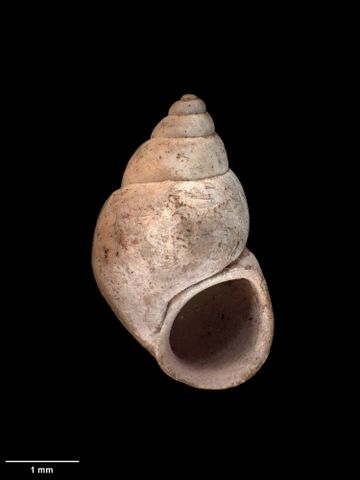
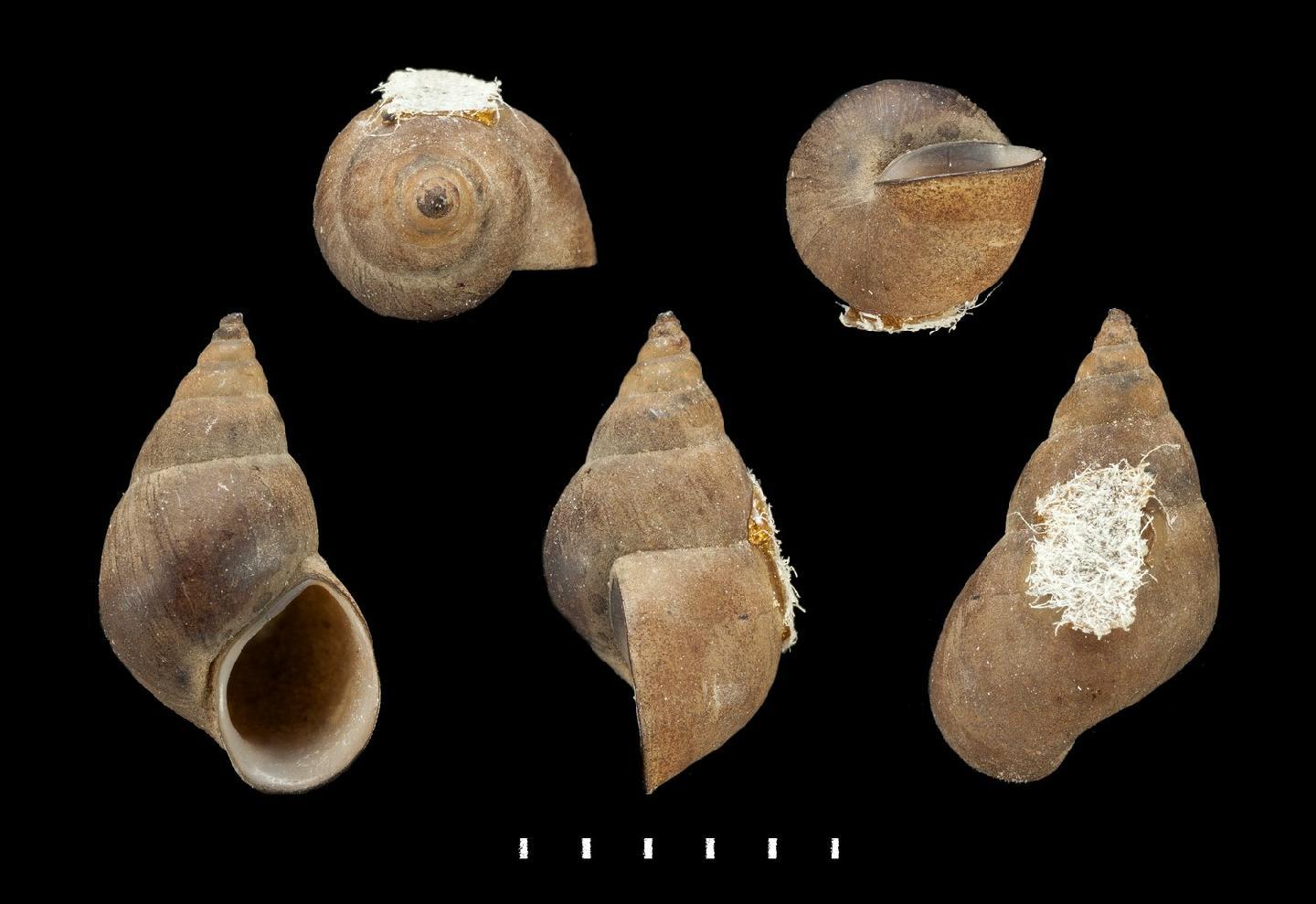


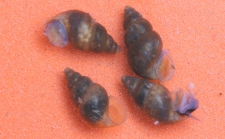
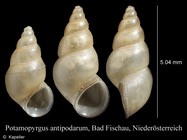
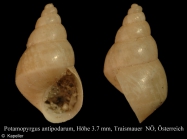
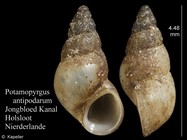


 carinata (7).jpg)
 carinata (3).jpg)
